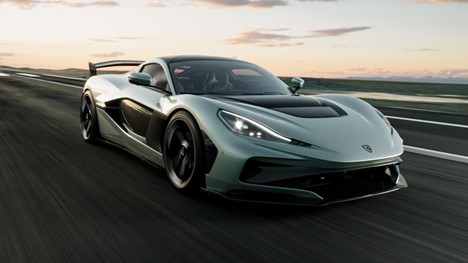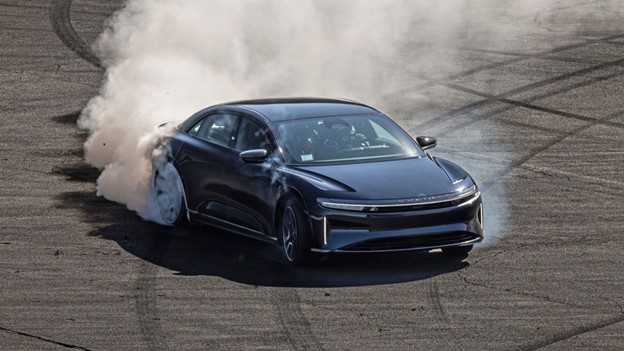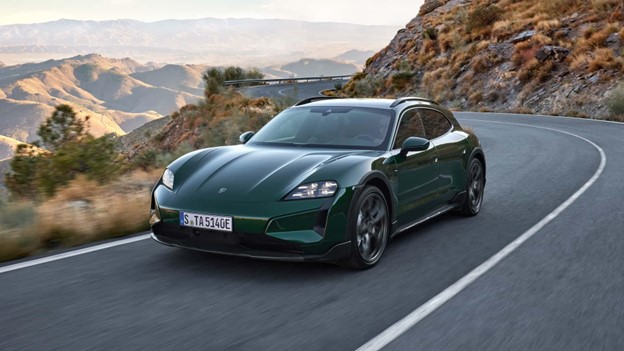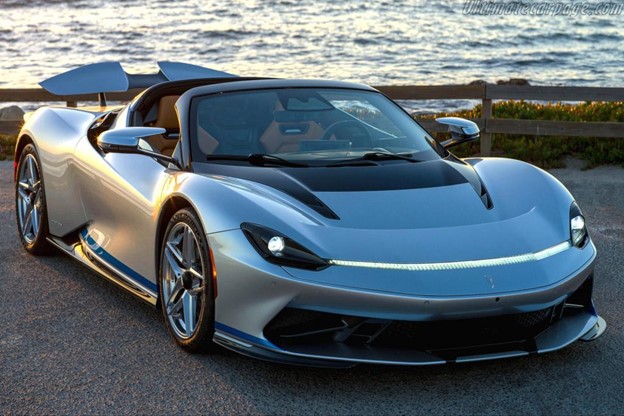The Fastest Electric Cars in the World
Electric cars are no longer just about efficiency and eco-friendliness—they are now pushing the limits of speed and performance, rivaling and even surpassing their gasoline-powered counterparts. Thanks to advancement in battery technology, aerodynamics, and instant torque, modern electric hypercars can reach stunning speeds although producing zero emissions.
In this report, we’ll peer into the fastest electric cars in the industry, analyzing their acceleration, top speed, power output, range, and fresh technologies that make them stand out.
Rimac Nevera

The Rimac Nevera is a new hypercar from Croatia-based Rimac Automobili. It isn't fast—it is the fastest electric production car in the industry, holding multiple records for acceleration and top speed.
| Feature | Specification |
| Top Speed | 412 km/h (258 mph) |
| 0-100 km/h | 1.74 seconds |
| Power Output | 1,914 hp |
| Range | 550 km (340 miles) |
| Price | $2.2 million |
The Nevera is powered by four independent electric motors, delivering instant torque to each wheel, allowing for exact handling and blistering acceleration. Unlike long-established and accepted supercars, which rely on gasoline engines and complex transmissions, the Nevera’s electric motors give power immediately, enabling it to achieve a 0-100 km/h time of just 1.74 seconds—making it one of the fastest-accelerating cars in history.
The Nevera’s 120 kWh battery pack is designed for both range and power, giving it an impressive 550 km range although still maintaining extreme performance. It also features a highly advanced cooling system, making sure that the battery does not overheat, even during intense driving sessions on the racetrack.
One of the most interesting aspects of the Nevera is its use of artificial intelligence (AI) driving assistance, which helps improve performance derived from driving conditions. The car is also hand-built, with only 150 units planned for production, making it an ultra-exclusive outstanding example.
Tesla Model S Plaid

Tesla has been new the EV revolution for years, and with the Model S Plaid, they have created the fastest production sedan in the industry. Unlike hypercars that cost millions, the Plaid delivers supercar-level performance at a much more accessible price.
| Feature | Specification |
| Top Speed | 322 km/h (200 mph) |
| 0-100 km/h | 1.99 seconds |
| Power Output | 1,020 hp |
| Range | 628 km (390 miles) |
| Price | $108,490 |
The Model S Plaid isn't a luxury electric sedan—it is a performance beast. With three electric motors and 1,020 horsepower, it achieves acceleration times that rival some of the most powerful hypercars. Tesla has successfully reached this performance with its advanced battery cooling technology, low drag coefficient, and lightweight chassis.
Tesla has also perfected its software and autopilot features, making the Model S Plaid one of the most intelligent EVs on the road. The interior is designed for maximum comfort, featuring a futuristic yoke steering wheel, a large touchscreen dashboard, and an advanced sound system.
Another major advantage of the Model S Plaid is its range—it can travel up to 628 km on a single charge, making it one of the longest-range electric cars currently available. And just like Tesla is revolutionizing the world of electric mobility, if you’re looking for a seamless and thrilling online gaming experience, Stay Casino login Australia offers an electrifying way to enjoy top-tier casino games with ease and convenience.
Clear Air Sapphire

Clear Motors has been causing a stir in the EV industry, and their latest Clear Air Sapphire is an ultra-luxury EV with hypercar-like performance. It combines elegance, comfort, and blistering speed in one package.
| Feature | Specification |
| Top Speed | 330 km/h (205 mph) |
| 0-100 km/h | 1.89 seconds |
| Power Output | 1,234 hp |
| Range | 687 km (427 miles) |
| Price | $249,000 |
The Clear Air Sapphire is the fastest luxury electric sedan, offering an peerless combination of speed and comfort. With its 1,234 hp tri-motor setup, it delivers breathtaking acceleration although maintaining a luxurious driving experience.
One of the biggest highlights of this car is its record-breaking range—at 687 km per charge, it has one of the longest ranges of any electric vehicle on the market.
Inside, the Air Sapphire features premium materials, a spacious cabin, and an advanced driver-assist system, making it not just fast but also one of the most comfortable high-performance EVs available.
Porsche Taycan Turbo S

Porsche’s entry into the EV market has been nothing short of stunning. The Taycan Turbo S combines Porsche’s signature handling and engineering with ultramodern electric performance.
| Feature | Specification |
| Top Speed | 260 km/h (162 mph) |
| 0-100 km/h | 2.8 seconds |
| Power Output | 761 hp |
| Range | 450 km (280 miles) |
| Price | $185,000 |
The Taycan Turbo S is built for performance, featuring Porsche’s high-performance all-wheel-drive system, two-speed transmission, and adaptive air suspension. It handles like a true sports car, delivering a changing driving experience unlike any other EV.
The Porsche engineering team has perfected the battery system for fast charging, allowing the Taycan to charge from 5% to 80% in just 22.5 minutes employing a 350 kW fast charger.
Although its range is lower than some competitors, the Taycan Turbo S offers an appropriate, track-ready driving experience that makes it one of the most exciting electric sports cars available today.
Lotus Evija

The Lotus Evija is one of the most fresh and futuristic electric hypercars in existence. Lotus, known for its lightweight sports cars, has taken its “simplify and add lightness” philosophy into the EV world, creating one of the most aerodynamically advanced electric cars ever.
| Feature | Specification |
| Top Speed | 350 km/h (217 mph) |
| 0-100 km/h | 2.9 seconds |
| Power Output | 2,000 hp |
| Range | 400 km (250 miles) |
| Price | $2.3 million |
The Evija is the industry’s most powerful production electric car, boasting an incredible 2,000 hp, thanks to four independent electric motors—one for each wheel. The car is built for speed, featuring active aerodynamics, a lightweight carbon-fiber monocoque, and venturi tunnels to improve airflow.
With a total weight of just 1,680 kg, it is one of the lightest electric hypercars ever made. The battery pack is positioned in the center of the car, lowering the center of gravity and making it incredibly agile on the track. The Lotus Evija is truly a fusion of extreme speed and ultramodern design, reconceptualizing what an electric hypercar can achieve.
Pininfarina Battista

The Pininfarina Battista is an all-electric hypercar from the famous Italian design house Pininfarina, known for creating some of Ferrari’s most famous models. It delivers stunning acceleration and power, although maintaining the luxurious styling expected from an Italian supercar.
| Feature | Specification |
| Top Speed | 350 km/h (217 mph) |
| 0-100 km/h | 1.86 seconds |
| Power Output | 1,900 hp |
| Range | 476 km (296 miles) |
| Price | $2.2 million |
The Battista shares its powertrain technology with the Rimac Nevera, producing an astonishing 1,900 hp from its four electric motors. But, what sets it apart is its luxury and design—Pininfarina has crafted the Battista to be both an ultra-fast hypercar and a comfortable grand tourer, featuring a beautifully finished high-tech interior with a target driver engagement.
The 0-100 km/h time of 1.86 seconds makes it one of the quickest cars in the industry, capable of outperforming almost any petrol-powered hypercar. With limited production (only 150 units worldwide), the Battista is one of the most exclusive and desirable EVs available.
Juxtaposition – Electric Hypercars contra. Gasoline Supercars
To grasp the differences between electric hypercars and long-established and accepted gasoline supercars, let’s compare their pivotal performance metrics in the table below.
| Category | Electric Hypercars | Gasoline Supercars |
| Acceleration (0-100 km/h) | ⚡ 1.74 sec (Rimac Nevera)
⚡ 1.86 sec (Pininfarina Battista) |
⛽ 2.4 sec (Bugatti Chiron)
⛽ 2.6 sec (Lamborghini Aventador SVJ) |
| Top Speed | ⚡ 412 km/h (Rimac Nevera)
⚡ 350 km/h (Lotus Evija) |
⛽ 490 km/h (Bugatti Chiron Super Sport)
⛽ 420 km/h (Koenigsegg Jesko) |
| Power Output | ⚡ 2,000 hp (Lotus Evija)
⚡ 1,914 hp (Rimac Nevera) |
⛽ 1,600 hp (Bugatti Chiron Super Sport)
⛽ 1,280 hp (Koenigsegg Agera RS) |
| Weight | ⚡ 1,680 kg (Lotus Evija)
⚡ 2,150 kg (Tesla Model S Plaid) |
⛽ 1,400 kg (McLaren P1)
⛽ 1,900 kg (Bugatti Chiron) |
| Handling | ⚡ Superior torque vectoring
⚡ Instant power distribution |
⛽ Lighter chassis
⛽ Better high-speed cornering |
| Range per Charge/Tank | ⚡ 550 km (Rimac Nevera)
⚡ 687 km (Clear Air Sapphire) |
⛽ 1,200 km (Ferrari SF90 Stradale)
⛽ 700 km (Lamborghini Huracán STO) |
| Refueling/Recharging Time | ⚡ 20-30 min (Fast Charging) | ⛽ 5 min (Gasoline Refill) |
| Environmental Lasting results | 🌱 Zero emissions, enduring energy | ⛽ CO₂ emissions, reliance on fossil fuels |
| Maintenance | ⚡ Fewer moving parts, lower maintenance costs | ⛽ More complex engines, higher maintenance |
| Price Range | ⚡ $100,000 – $2.5M (Luxury & Hypercars) | ⛽ $150,000 – $3M+ (Supercars & Hypercars) |
Truth
The fastest electric cars in the industry are proving that EVs can be just as exciting, powerful, and thrilling as their gasoline-powered counterparts. With advancement in battery technology, aerodynamics, and electric motors, these cars are not only faster but also more productivity-chiefly improved and enduring.
From the record-breaking Rimac Nevera to the practical yet insanely fast Tesla Model S Plaid, the EV industry is all the time pushing the limits of what is possible. As technology continues to grow, we can expect even faster, more powerful, and more productivity-chiefly improved electric cars to control the roads in the near .
